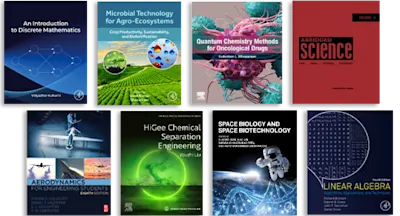
Communication Satellite Systems Technology
A Collection of Technical Papers Drawn Mainly from the AIAA Communications Satellite Systems Conference, May 2-4, 1966
- 1st Edition, Volume 19 - December 3, 2014
- Latest edition
- Editor: Richard B. Marsten
- Language: English
Communication Satellite Systems Technology reviews the state of the art in communication satellite systems technology. Topics covered range from commercial point-to-point systems… Read more

Communication Satellite Systems Technology reviews the state of the art in communication satellite systems technology. Topics covered range from commercial point-to-point systems and military satellite communication systems to satellite support subsystems and components, along with high-power systems. Communication satellites are also discussed from a sociological perspective. Comprised of 50 chapters, this book begins with a 1945 article by Arthur C. Clarke in which he proposed the construction of rocket space stations in orbit that would provide complete radio coverage of the globe as well as extraterrestrial relay services. The reader is then introduced to the Early Bird satellite and its hydrogen peroxide orbit control and orientation system. Details of the sequence of maneuvers required after transfer ellipse injection until final placement in a stationary orbit are given. The methods of calculation of maneuver parameters, as well as numerical examples of certain Early Bird orbit changes and maneuver parameters, are described. The effects of the principal long-term disturbing forces on the satellite are also considered. Subsequent chapters focus on military satellite communication systems; satellite support subsystems and components; high-power systems; and systems concepts. The organization and program of Intelsat are also evaluated. This monograph will be of value to practitioners in the fields of aeronautics, astronautics, and satellite communications.
The Communications Committee, 1965 and 1966
Preface
Prologue: An Historical Prophecy
Extra-Terrestrial Relays
I. Commercial Point-to-Point Systems
Early Bird Placement in a Stationary Orbit: Launch and Control System Maneuvers
Early Bird I Communications Parameters
Experimental Performance of the Early Bird Communication System
Results of User Reaction Tests on Communication Via Early Bird Satellite
Subjective Evaluation of Telephone Communications Via Early Bird Satellite and Cable Circuits
II. Military Satellite Communication Systems
Experience of the Defense Communications Agency in Operating Pilot Satellite Communications
Communications Via Several Satellites Using the Lincoln Experimental Terminal
Optimization of Network Configurations in a Hybrid Satellite and Ground Communication System
Synchronization of a Jam-Resistant Mobile Small-Terminal Satellite Communications System
Decentralized Control for an Advanced Communication Satellite System
Fading and Multipath Considerations in Aircraft/Satellite Communications Systems
A Multiple-Access World-Wide Satellite Communication System for Aircraft Terminals
Adaptive Digital Satellite Transmission Ground Terminal Design Considerations
An Adaptive Twelve-Channel Multiplexer
Cost Effectiveness Comparison of Defense Communications Satellite Systems
III. Satellite Support Subsystems and Components
Launch Vehicles as Support Subsystems for Communications Satellites
Synchronous Satellite Station-Keeping
Gravity Gradient Stabilization of Communication Satellite Systems
Stabilite - - A Three-Axis Attitude Control System Utilizing a Single Reaction Wheel
A Wide-Band Solid-State I. F. Repeater for Communications Satellites
Advances in Traveling-Wave Tubes for Spacecraft Communications Systems
An Electronically Despun Switched Antenna
Ground-Based Antennas for Satellite Communications
Gain Limits of Electronically Despun Antennas for Communication Satellites
IV. High-Power Systems
Nuclear Power Systems for Advanced High-Powered Communications Satellites
High-Powered Traveling-Wave Tubes for Space Transmitters
A Direct-to-Home TV Satellite System for 1970
Self-Steering Arrays for Satellite Applications
Earth Stations for Reception of Television Signals from a Stationary Satellite
Required and Attainable Interference Ratios in Space Telecasting
V. Systems Concepts: Present and Future
Parametric Tradeoff Analysis for Comsat System Design
Multiple-Access Modulation Techniques
A Communication Satellite System for Many Users
Use of Frequency-Time Coded Pulsed Signals in Satellite Communications Systems
TV Network Satellite Systems
Establishment and Maintenance of a Communication Satellite System
Scheduling and Control of Satellite Communications Systems
Ground and Satellite Telecommunications Networks for Global Information Systems
Aeronautical Communication Satellites
Post Echo II Passive Communication Satellites and Systems
Orbit Position Control for Passive Communications Satellites
Some Design Considerations for Planetary Relay Communications Satellites
Lunar Communication Satellites
Deep-Space Optical Communications
VI. Sociological Overview
Preface to Chapter VI
Organization and Program of Intelsat
Business Forecasting for Communication Satellite Systems
Future Pattern of Communication Satellite Systems
An Econometric Analysis of an Educational TV Distribution System
Communications in Orbit: A Legal Analysis and Prognosis
European Perspectives on Satellite Communications
- Edition: 1
- Latest edition
- Volume: 19
- Published: December 3, 2014
- Language: English
Read Communication Satellite Systems Technology on ScienceDirect